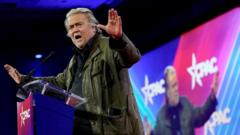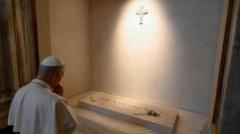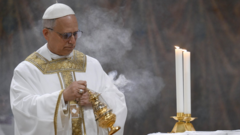**Pope Francis’ funeral, steeped in tradition but marked by humility, demonstrates his legacy of inclusion, drawing international leaders and faithful alike to commemorate the pontiff who endeavored to reshape the Catholic Church.**
**Thousands Pay Respects as Pope Francis is Laid to Rest**

**Thousands Pay Respects as Pope Francis is Laid to Rest**
**World Leaders and Faithful Mourn Together at Pope Francis’ Funeral - A Reflection of His Inclusive Legacy**
Mourners gathered in Saint Peter's Square in Vatican City on April 26, 2025, for the funeral of Pope Francis, who passed away at the age of 88 on April 24, following a pandemic of health challenges. The funeral was set to be witnessed by a congregation of tens of thousands, comprising both religious leaders and ordinary believers, as well as global dignitaries, signaling the profound impact he had during his twelve-year papacy.
Pope Francis, known for his efforts to establish a more inclusive Catholic Church, had requested changes to the traditional papal funeral rites. In 2024, he approved guidelines that emphasized humility and simplicity, reflecting his persona as a “humble pastor.” As a result, his funeral, while following centuries-old liturgical customs, would be less grandiose than those of his predecessors. Attendees were expected to include prominent figures like President Biden, former President Trump, and President Javier Milei of Argentina.
The ceremony, presided over by Cardinal Giovanni Battista Re, begun promptly at 10 a.m. local time. Attendees witnessed a mix of ancient rituals, including red-robed cardinals and Gregorian chants, amidst the stirring ambiance of collective mourning in Vatican City.
After the Mass, Pope Francis’ unadorned wooden coffin was to be transported to Santa Maria Maggiore Basilica, one of his favored churches, where he would be laid to rest in a simple tomb inscribed simply with the name "Franciscus".
As dignitaries and faithful said their goodbyes, the occasion transpired amidst geopolitical tensions, with leaders from conflicting nations sharing the same space, highlighting Francis' independent moral stance on multiple global issues during his time as pontiff. The seating arrangements, utilizing an alphabetically ordered method as per Vatican protocol, aimed to mitigate any potential discomfort among attendees.
Francis’ contributions to the Church, focusing heavily on advocacy for the marginalized, the environment, and the importance of humility, have left a significant legacy. His call for inclusion resonated with many of the faithful and shaped the Church’s dialogue on contemporary social issues, leading to both support and contention within different spheres of the Catholic community.
As the public funeral Mass drew to a close, attention turned towards the task of selecting his successor, with the Catholic world soon to engage in a process imbued with the potential for diverse theological perspectives and leadership styles in the future.
Overall, the funeral served as a reflection of Pope Francis’ commitment to fostering a Church that is more considerate and inclusive, honoring his memory as a pontiff who sought to connect believers to the tenets of faith in their daily lives and societal obligations.






















